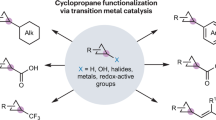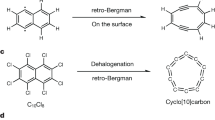Abstract
DR. Walsh has defended his suggested structure1 for the compounds ethylene oxide and cyclopropane in terms of a molecular orbitals picture based on the assumption that the carbon atoms are in the trigonal, or near-trigonal, state. The calculations by Linnett2 of the CH-bond force-constants are consistent with trigonal bonding.
This is a preview of subscription content, access via your institution
Access options
Subscribe to this journal
Receive 51 print issues and online access
$199.00 per year
only $3.90 per issue
Buy this article
- Purchase on SpringerLink
- Instant access to full article PDF
Prices may be subject to local taxes which are calculated during checkout
Similar content being viewed by others
References
Walsh, A. D., Nature, 159, 165 and 712 (1947).
Linnett, J. W., Nature, 160, 162 (1947).
Bastiansen and Hassel, Tids. Kjemi Bergvesen Met., 6, 71 (1946).
Pauling and Brockway, J. Amer. Chem. Soc., 59, 1223 (1937).
Smith, L. G., Phys. Rev., 59, 924 (1941).
O'Gorman and Schomaker, J. Amer. Chem. Soc., 68, 1138 (1946).
See, for example, Skinner, H. A., Trans. Farad. Soc., 41, 645 (1945).
Author information
Authors and Affiliations
Rights and permissions
About this article
Cite this article
SKINNER, H. Structure of Cyclopropane. Nature 160, 902 (1947). https://doi.org/10.1038/160902a0
Issue date:
DOI: https://doi.org/10.1038/160902a0



